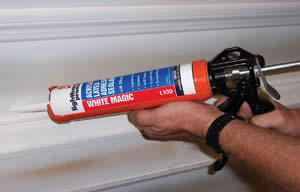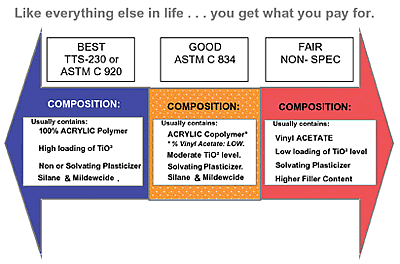
Sealants, Caulks,
Caulking Guns
Selecting a sealant requires an understanding of the joint: the width and the amount of movement expected. Sealants are tested to federal specifications or standards set by ASTM.
by Ray Heck
in construction projects takes more than a strong wrist and a steady hand. Successful gap-filling starts with selecting the right sealant for the job and continues with proper surface preparation and application.
Painters can err by selecting the wrong type of sealant or expecting too much from it. Selecting a sealant requires an understanding of the joint: the width and the amount of movement expected. Sealants are tested to federal specifications or standards set by ASTM. They receive different ratings based on their ability to move, flex and return to their original configuration. Choices must be made after considering the amount of expansion and contraction the joint will experience at the extreme temperature ranges of the area.

Sealants used in commercial construction may be specified by the owner, architect or engineer; however, the contractor often has final say on brand and type. Generally, commercial construction-grade sealants must meet ASTM C-834, ASTM C-920 or Federal specification TT-S-00230. Every manufacturer of quality products tests their products and labels the caulk tubes accordingly.
- High performance: ASTM C 920/TT-S230, 25% and 12.5% joint movement capability
- Premium: ASTM C 834, Grade 18° C has good flexibility at — 18° C
- Midpoint: ASTM C 834, grade 0° C has good flexibility at 0° C
- Economy: No Specification. All purpose sealant with average flexibility and adhesion
Sealant selection is very much performance-based. Answering these questions before you begin will help you select the best sealant for the job:
- What is the substrate?
- Is it an inside or outside application?
- How much joint movement is required?
- Is this an above — or below-ground application?
- What is the ambient and surface temperature at the time of application?
- Does the sealant need to be paintable or must it match the substrate?
Generally, caulks and sealants are members of one of the following types of chemical families. Like any family, each has strong points, weak points and idiosyncrasies that can make it a very good — or very poor — match for the job at hand.
Polyurethanes: While these reactive- or chemical-curing compounds are difficult to gun and tool and require solvent cleanup, they have excellent flexibility and have good to excellent durability. Some must be applied to a primed surface, but in general they adhere well to a variety of surfaces. They shrink little while curing and can withstand traffic once cured. Even if the surface degrades with heavy traffic, the compound will still maintain an effective seal. They tend to be more expensive than other types of sealants. Once cured, polyurethanes have limited paintability and may react with alkyd- or oil-based paints.
Silicones: Silicones are also reactive-curing compounds, but they offer easy gunning ability. Their jelly-like consistency makes them hard to tool for a nice finish, but they cure quickly and will cure at below-freezing temperatures. Once cured, they are very flexible, extremely durable and resist ultraviolet light degradation. They maintain their properties over a wide temperature range. Most 100% silicone-based compounds cannot be painted. Because they are hard to remove completely, especially on porous surfaces, repairs and future painting can be difficult. New silicone may not stick to old silicone, so proper surface preparation is the key to successful sealant repairs where silicones have been used.
Acrylics: These are the most common in the paint industry and come in a variety of formulations that affect cost, durability and adhesion. They are easy to gun and because they are water-based, they clean up easily. They are low in cost and come in a wide range of performance grades. Typically, the higher the cost, the greater the performance you can expect.
Acrylics cannot be applied in wet or freezing conditions or at temperatures over 100° F. All acrylics are paintable, and no primer is needed before application. Many are available in colors to match substrate, eliminating the need for painting.
Urethane hybrid blended acrylics are at the high end of the acrylic family in cost and performance and can often be used in a variety of applications where a silicone or polyurethane sealant may be used. |

